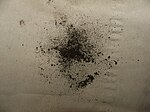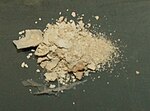Stannous oxide
 |
|
 |
|
 |
|
| Names | |
|---|---|
|
IUPAC name
Tin(II) oxide
|
|
| Other names
Stannous oxide, tin monoxide
|
|
| Identifiers | |
|
21651-19-4 |
|
| 3D model (Jmol) | Interactive image |
| ECHA InfoCard | 100.040.439 |
| EC Number | 244-499-5 |
| PubChem | 88989 |
| RTECS number | XQ3700000 |
|
|
|
|
| Properties | |
| SnO | |
| Molar mass | 134.709 g/mol |
| Appearance | black or red powder when anhydrous, white when hydrated |
| Density | 6.45 g/cm3 |
| Melting point | 1,080 °C (1,980 °F; 1,350 K) |
| insoluble | |
| −19.0·10−6 cm3/mol | |
| Structure | |
| tetragonal | |
| Thermochemistry | |
|
Std molar
entropy (S |
56 J·mol−1·K−1 |
|
Std enthalpy of
formation (ΔfH |
−285 kJ·mol−1 |
| Hazards | |
| Safety data sheet | ICSC 0956 |
| Flash point | Non-flammable |
| US health exposure limits (NIOSH): | |
|
PEL (Permissible)
|
none |
|
REL (Recommended)
|
TWA 2 mg/m3 |
|
IDLH (Immediate danger)
|
N.D. |
| Related compounds | |
|
Other anions
|
Tin sulfide Tin selenide Tin telluride |
|
Other cations
|
Carbon monoxide Silicon monoxide Germanium(II) oxide Lead(II) oxide |
| Tin dioxide | |
|
Except where otherwise noted, data are given for materials in their standard state (at 25 °C [77 °F], 100 kPa).
|
|
|
|
|
| Infobox references | |
Tin(II) oxide (stannous oxide) is a compound with the formula SnO. It is composed of tin and oxygen where tin has the oxidation state of +2. There are two forms, a stable blue-black form and a metastable red form.
Blue-black SnO can be produced by heating the tin(II) oxide hydrate, SnO·xH2O (x<1) precipitated when a tin(II) salt is reacted with an alkali hydroxide such as NaOH.
Metastable, red SnO can be prepared by gentle heating of the precipitate produced by the action of aqueous ammonia on a tin(II) salt.
SnO may be prepared as a pure substance in the laboratory, by controlled heating of tin(II) oxalate (stannous oxalate) in the absence of air or under a CO2 atmosphere. This method is also applied to the production of ferrous oxide and manganous oxide.
Tin(II) oxide burns in air with a dim green flame to form SnO2.
When heated in an inert atmosphere initially disproportionation occurs giving Sn metal and Sn3O4 which further reacts to give SnO2 and Sn metal.
SnO is amphoteric, dissolving in strong acid to give tin(II) salts and in strong base to give stannites containing Sn(OH)3−. It can be dissolved in strong acid solutions to give the ionic complexes Sn(OH2)32+ and Sn(OH)(OH2)2+, and in less acid solutions to give Sn3(OH)42+. Note that anhydrous stannites, e.g. K2Sn2O3, K2SnO2 are also known. SnO is a reducing agent and this appears to its role in the manufacture of so-called "copper ruby glass".
Black, α-SnO adopts the tetragonal PbO layer structure containing four coordinate square pyramidal tin atoms. This form is found in nature as the rare mineral romarchite. The asymmetry is usually simply ascribed to a sterically active lone pair; however, electron density calculations show that the asymmetry is caused by an antibonding interaction of the Sn(5s) and the O(2p) orbitals.
Non-stoichiometry has been observed in SnO.
The electronic band gap has been measured between 2.5eV and 3eV.
...
Wikipedia
